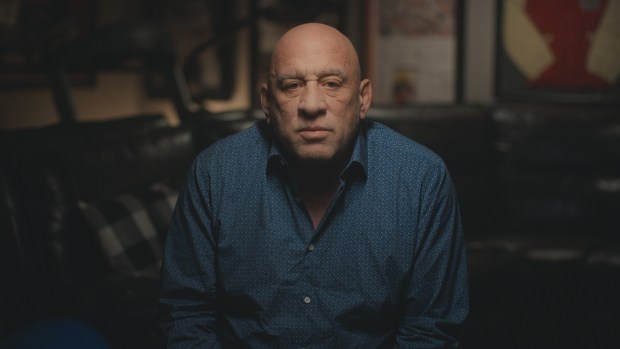According to a report commissioned by Ohio State University, a sports medicine physician employed by the college was responsible for least 177 instances of sexual abuse committed over a 20-year period, from 1978 to 1998. The experiences recounted by male athlete alumni in filmmaker Eva Orner’s HBO documentary “Surviving Ohio State” are devastating and the contours of the story resemble those of so many other sex abuse scandals. That’s not a mark against the film, but an observation that the harm tends to unfold in what are, by now, familiar patterns.
Richard Strauss was the team doctor at Ohio State across numerous sports, including wrestling, hockey and fencing. That 177 number only accounts for those who came forward, but one person estimates that thousands of students were likely affected during the years of Strauss’s employment.
News anchor Colleen Marshall was one of the journalists who looked into the allegations early on in 2018, and she is interviewed here as well: “Who was this accused doctor? I had trouble finding any information about him. It’s very difficult to find a photograph of this Dr. Richard Strauss. The university itself doesn’t have a lot of photographic evidence of this man. He’s like an enigma. It’s weird. It almost felt like it was by design. And that made this all the more troubling.”
Here’s how one survivor sums up their contact with Strauss: “If we had an illness, he’s the one we went to. If we needed medication for something, he’s the one that we went to. If we had an injury, he’s the one that we went to. And each and every time, it was a full-body check that resulted in a genital check, without fail. And the man never wore gloves. It was always skin on skin.” As one hockey player remembers: “Once I got a slap shot off my foot, and first thing he said was ‘Drop your trousers.’” More than one student remembers feeling Strauss’ breath on their groin.
The documentary is based on reporting by Sport Illustrated’s Jon Wertheim, and focuses on students who attended Ohio State in the late ’80s and early ’90s who were galvanized to come forward after seeing women gymnasts disclose the abuses of Larry Nassar, who was employed at Michigan State University and was medical coordinator for USA Gymnastics. An OSU student following that case said he instantly related to the women’s stories and recalls thinking: “Wow, that’s us.”
Nassar ultimately pleaded guilty to criminal sexual assault and is serving a decades-long sentence in federal prison. Strauss died by his own hand in 2005, more than 10 years before OSU commissioned its report, so there can be no similar legal outcome, which is perhaps why the story itself might be less well-known. Without a criminal trial, it has been gone from the news cycle. However, the wrestlers featured here are pursuing a lawsuit against the university.
Dan Ritchie is one of those survivors. He is a school teacher and remembers his colleagues talking about the Strauss allegations when they first broke. “One day I’m sitting in our teachers’ lounge and some of the other guys are talking about it and one of the male teachers, he was an older guy, he said, ‘Well, I can’t believe that — if I was there, if this happened to me, I’d kick that guy’s ass.’ And I’m thinking, man, you have no idea what you’re talking about. And the next thought was: I’m gonna have to talk about this. Oh (expletive), here we go.” (George Clooney and Grant Heslov are among the documentary’s producers).
“Surviving Ohio State” is upsetting and devastating, but also deeply sad because — as is common in similar cases — the film presents claims that those in positions of power looked the other way or tried to bury concerns when they were raised. One man says his mom asked him if he told the coaches, but “telling would imply that they didn’t know.” The issues with Strauss were an open secret “that we all just tiptoed around and we just dealt with it because we’re Buckeyes,” someone else says. One athlete recalls going to his coach: “And he just said to me, ‘Don’t worry about the doctor, worry about your playing.’”
There’s a brief moment in the film when we glimpse of someone wearing a T-shirt that says “shut up & train,” and it underscores so much.
I was struck by how Orner quietly but firmly makes clear that responses to these kinds of traumatic experiences don’t necessarily differ because of gender. Did you fight back? Did you say no? These are questions women face when disclosing an assault. It’s instructive, I think, to hear men — young athletes in peak condition who were bigger and physically stronger than Strauss — describe the horror and violation of unwanted sexual touch, and that their reaction to being assaulted was to freeze.
There were significant power differentials at play as well. Strauss had the authority to withhold an athlete’s clearance to compete. Putting their hands on Strauss could have jeopardized their scholarships or their place at the university. One former hockey player says Strauss drugged him under the guise of providing medical care, and then subsequently raped him. “I don’t know one guy that regularly goes to a doctor, none of ’em. It’s really bad,” another survivor says.
“It was and still is one of the best-equipped, most well-funded, most lavish athletic departments in the country,” someone observes. “The Buckeyes are a religion,” is a phrase used to describe the university’s larger-than-life hold on people. It’s difficult to not come away thinking that’s a key part of the problem.
“Surviving Ohio State” — 3 stars (out of 4)
Where to watch: 8 p.m. Tuesday on HBO (streaming on HBO Max)
Nina Metz is a Tribune critic.



